Account-Based Marketing for manufacturers
Target and engage ideal customers for optimal results.

/Newsletter/Equinet_2024/abm-mockup-2024.webp?width=1080&height=600&name=abm-mockup-2024.webp)
No time to read now?
The B2B marketing and sales landscape has changed, especially for outsourced services. Acquiring new clients today is very different from even a few years ago.
In a digitised world where buyers independently research and evaluate options—often without engaging vendors until late in the process—being known, seen, and remembered takes deliberate effort and strategic visibility.
To thrive, contract manufacturers must actively identify and engage their best-fit prospects. An account-based Marketing (ABM) strategy can mean the difference between steady growth and stagnation.
Think of it this way: Inbound marketing helps you get found by buyers who are already in the market. ABM is how you proactively engage ideal customers before they're ready to buy—and guide them into the market when the timing is right.
What is Account-Based Marketing?
Account-based marketing (ABM) is a highly focused business strategy in which marketing and sales teams work together to target and engage individual high-value accounts. Unlike traditional approaches that cast a wide net with broad marketing efforts,
ABM focuses on specific organisations most likely to benefit from and purchase a company's products or services. This targeted approach involves creating personalised campaigns tailored to each account's unique needs, pain points, and goals, fostering more profound and relevant connections.
The core principle of ABM is precision. By identifying and understanding the key decision-makers and influencers within a target account, businesses can deliver relevant, timely and impactful messages that will resonate with these accounts' specific challenges and objectives.
This enhances engagement by ensuring that marketing efforts are directly aligned with the priorities of target accounts. Furthermore, ABM facilitates better alignment between marketing and sales teams, promoting a collaborative approach that improves efficiency and effectiveness.
In addition to its strategic focus, ABM leverages advanced data analytics, technology, market research and sizing to refine targeting and measure success. Tools like your CRM, marketing automation, and AI-driven insights can be crucial in identifying the best-fit accounts and delivering personalised experiences at scale.
Benefits of ABM for contract manufacturers
ABM upends the traditional B2B sales and marketing funnel by shifting the focus from a broad audience to high-value, pre-qualified accounts. This lets B2B manufacturers identify prospects more likely to convert, resulting in a more focused sales process that is more likely to drive growth.
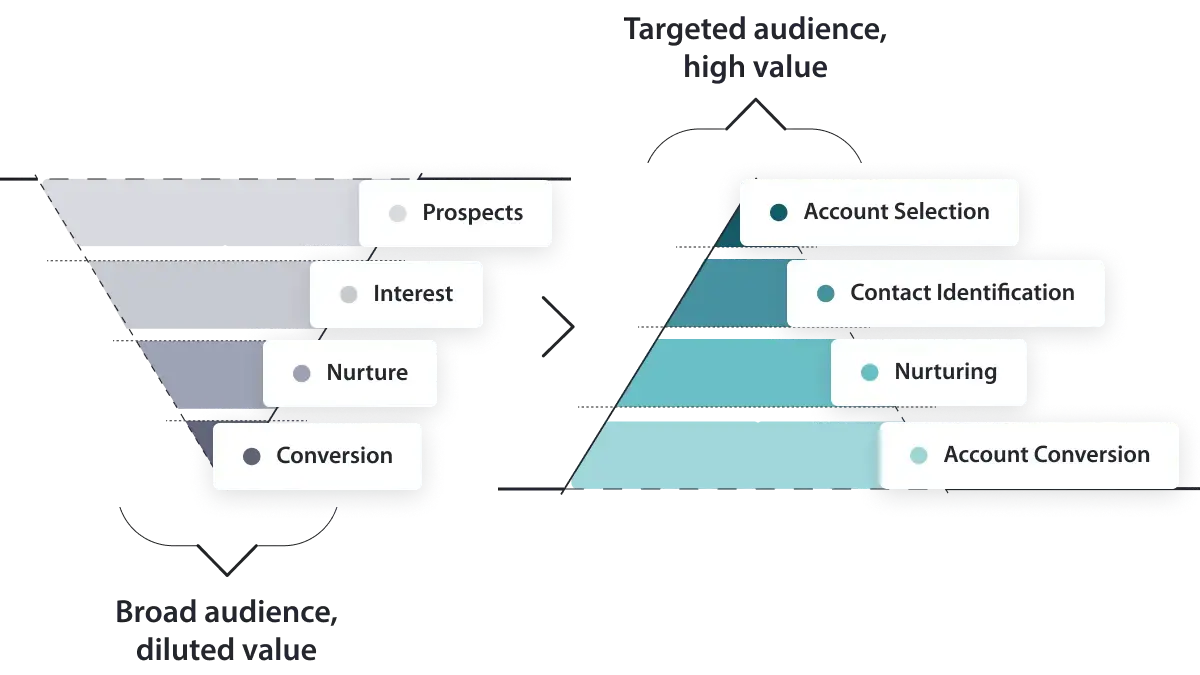
Studies have shown that ABM strategies can generate up to 208% more revenue for companies than traditional marketing methods, highlighting its efficacy in driving substantial financial returns.
Moreover, teams can better measure and track marketing efforts with ABM, allowing for continuous optimisation and refinement. Marketers can closely monitor which strategies yield the highest returns and adjust their ABM tactics accordingly. This data-driven approach improves campaign performance over time while providing clear justification for marketing expenditures, making it easier to demonstrate the value of marketing initiatives to stakeholders when the time comes for budgeting discussions.
Better sales and marketing alignment
One of the benefits of ABM is its ability to foster more substantial alignment between sales and marketing teams. In traditional marketing models, these departments often operate in silos, leading to miscommunication, process inefficiencies, and missed sales opportunities.
ABM, however, necessitates close collaboration as both teams work together to identify target accounts, develop tailored strategies, and nurture leads through the sales funnel.
By kindling a more unified approach, ABM ensures that marketing efforts are directly aligned with sales goals, resulting in a more cohesive growth strategy overall.
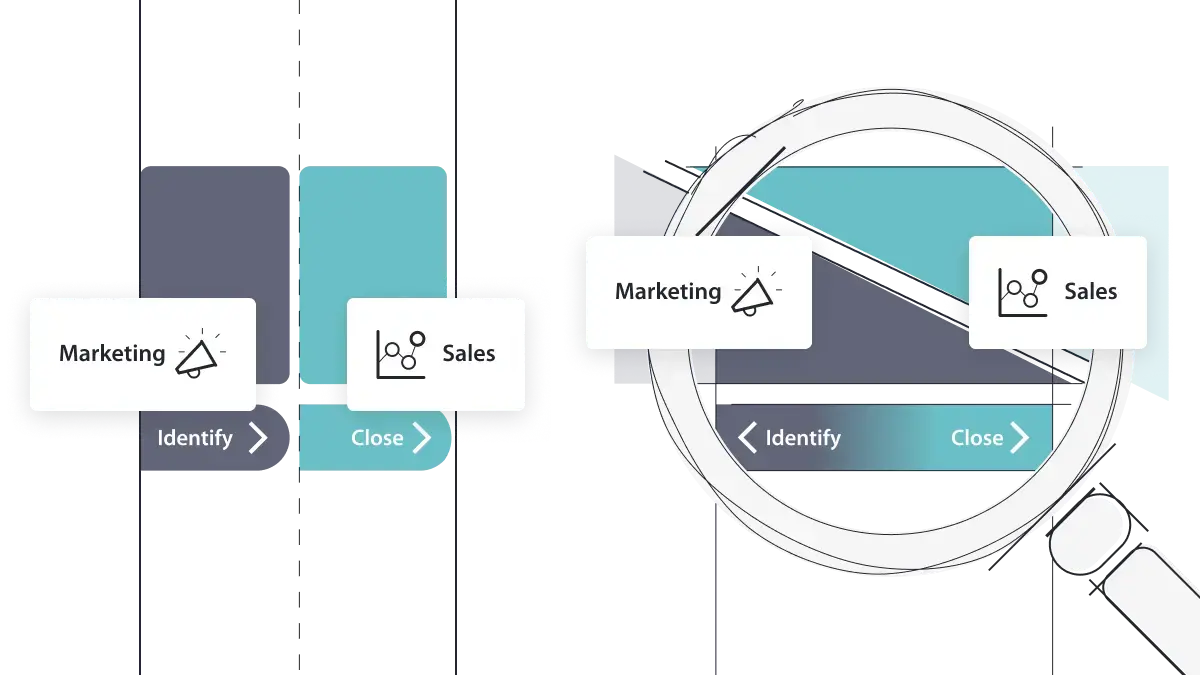
When marketing and sales teams collaborate, they create more accurate and detailed buyer personas, ensuring that marketing messages are relevant and compelling to target accounts.
This synergy accelerates the sales cycle, improves lead quality and customer engagement, and enhances the overall customer experience, as prospects receive consistent and personalised communication throughout their journey.
Personalised customer experiences
Marketing personalisation can enhance any strategy, and ABM excels in delivering individualised customer experiences that make prospects feel seen. By focusing on a select group of high-value accounts, marketers can tailor messaging and content to the key people in each account, acknowledging and addressing specific needs, pain points, and goals. This can create a more meaningful and engaging interaction with potential customers.
Personalised account-based experiences like this foster deeper relationships and trust between businesses and their clients. When prospects feel understood and valued, they are more likely to engage with the brand and move forward in their buying journey.
The ABM process
Step one: Identify target accounts
The first step in the ABM process is to identify and select the high-value accounts that will be the focus of your marketing and sales efforts. This involves analysing your ideal customer profile, understanding which prospect accounts have the highest revenue/margin potential, and using data-driven insights to build a list of target accounts.
Narrowing down the right accounts can be complex, so teams need to work together to combine insights and perspectives to build a balanced list. Too few target accounts could mean a higher risk of failure, while too many target accounts could mean diluted efforts and reduced ROI.
Questions to consider when building out your list:
- Which industries and company sizes are most profitable for us?
- How do potential accounts compare to our ideal customer profile regarding revenue potential?
- What characteristics do your most successful and satisfied customers share?
- What do sales already know about a target account that could influence inclusion?
- What patterns of behaviour indicate interest or buying intent?
- Have target accounts interacted with our content and campaigns? How?
- What online behaviours suggest that an account is in the market for our solutions?
- Do you have accounts with significant upsell or cross-sell opportunities?
The three main types of ABM
Too many targets will stretch resources and almost certainly dilute results. However, too few targets (less than three) could be a high-risk strategy but potentially favourable for exceptionally high-value deals. You can use three types of ABM to find the right balance between the number of target accounts and the resource investment required.
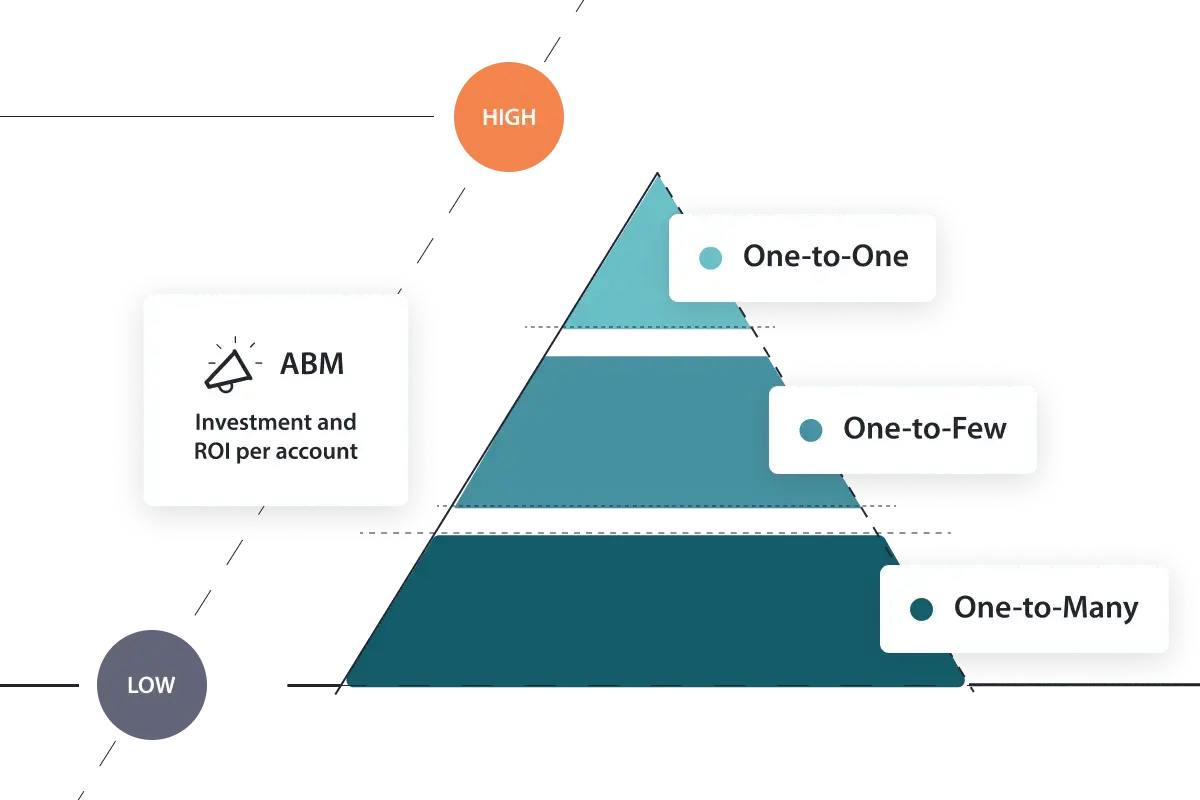
One-to-one ABM, or strategic ABM, creates highly personalised marketing campaigns for an individual, high-value account. Its value lies in building strong, long-term relationships with key accounts by providing tailored solutions and personalised interactions. This type of ABM is typically employed for accounts that represent significant revenue potential and require high customisation and attention.
One-to-Few ABM, or ABM Lite, targets clusters of accounts that share similar characteristics or needs. This approach allows for personalisation while benefiting from economies of scale. By grouping accounts with commonalities, marketers create semi-customised campaigns targeted to each group, leveraging insights that apply across the cluster. The value of One-to-Few is its balance between personalisation and scalability. It enables marketers to address the specific needs of multiple accounts without the resource intensity required for One-to-One ABM, making it an effective strategy for mid-tier accounts.
One-to-Many ABM, or Programmatic ABM, involves targeting more accounts with personalised marketing messages using automation and data analytics. This type of ABM leverages technology to deliver tailored campaigns at scale, focusing on a broad set of accounts that fit within predefined criteria. The value of One-to-Many ABM is its ability to reach a broad audience with personalised messages while maintaining efficiency and cost-effectiveness. It is ideal for companies looking to engage many potential accounts without the need for intensive manual personalisation efforts.
Step two: Define the buying committee
To successfully execute your ABM strategy, you must map out as many buyers and influencers in each target account as possible to define the buying committee. This step involves identifying key roles such as "Champions", "Decision makers", "Budget holders", "Influencers", and "Blockers". Each role plays a distinct part in the decision-making process, and understanding where the real power and authority lie within the buying committee is essential.
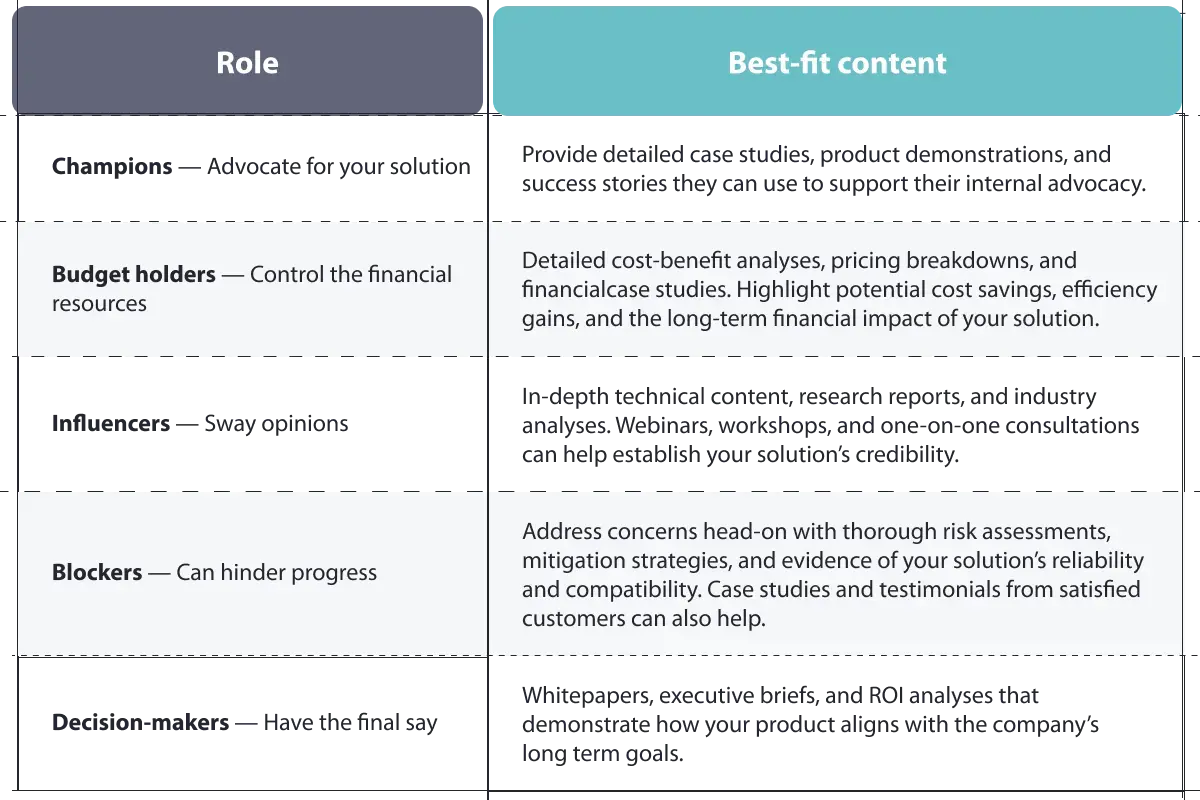
This process aims to deliver relevant messages and experiences to everyone involved in the purchase decision over time. By mapping and engaging with all relevant contacts, you enhance your storytelling and ensure that each message your brand sends will connect with different stakeholders' specific concerns and needs.
Engaging with the entire buying committee requires a coordinated effort. The more relevant contacts you can identify and nurture, the greater your chances of securing buy-in from all necessary parties. This comprehensive approach ensures that everyone involved understands and appreciates your value proposition, reducing the risk of objections and increasing the likelihood of successfully advancing a sale. By systematically addressing the needs and concerns of each role within the buying committee, you can build stronger relationships and foster trust, ultimately driving more effective and efficient sales outcomes.
Step three: Create personalised content and campaigns
Based on the insights gathered and the personas defined, develop personalised content and campaigns tailored to each target account's specific needs and pain points to attract these relevant prospects. Attracting these target accounts could lead to formal or informal 'face-time' with multiple stakeholders.
Account-Based Content Marketing
Highly personalised, strategic content expressly written for the target audience is required to take target accounts on a buying journey through to decision. When crafting your content, focus on quality, relevance, tone, and directness.
"The best ABM strategies have a content component. When you combine ABM with content marketing, you're doing account-based content marketing (ABCM or ABC Marketing)."
- Andy Crestodina, Orbit Media
Key questions to consider about the content you plan:
- What are the needs of my target accounts?
- What challenges are they currently facing?
- How do they consume content?
- What types of content do they prefer?
- What types of buyer roles are involved?
Ensure you have the right content for all personas at every buyer journey stage:
Awareness stage: Thought leadership pieces that include original research, highlighting your deep market knowledge, such as articles, whitepapers, educational webinars and infographics.
Consideration stage: More granular content pieces that include case study stories (without the brand), guides, or service-focused collateral like fact sheets, webinars, or email sequences.
Decision stage: This content is more specific. It should reinforce your understanding of the account's unique challenges and objectives with pieces like video testimonial stories (albeit without the brand, more often than not) and tailored proposals that outline how your services will meet the needs of the target account.
If you have little awareness with a target account and want to build your brand association, focus more content on the awareness stage. Conversely, if you have brand traction but prospects are not converting, consider content effectiveness at the consideration stage. Also, leverage information and insights from Sales and refine your content based on their performance as you go.
Advertising
1-2-1 LinkedIn advertising can be compelling. Nowadays, marketers can target ads by geography, job title, interest and recognised company email address—even if a contact is not in your CRM. You can engage decision-makers with precise digital advertising and LinkedIn Sponsored Content on your target accounts. Savvy digital marketers can leverage ad networks across digital channels like Google and over 200 million data points to engage the right people proactively.
You can also personalise messages and CTAs. For example, a financial director in a target company can receive a different message from the operations director of the same company. Combine LinkedIn ads with direct messaging to reach your audience in this way. However, avoid cold pitches; build relationships over time before inviting them to events.
ABM advertising is typically used for:
- Attracting the right contacts within target accounts
- Engaging contacts using 'push' and 'pull'
- Capturing active buying signals
- Identifying highly engaged target accounts
- Re-targeting engaged accounts with personalised messages
- Accelerating prospects closer to revenue
- Remarketing
Paid Social
Sponsored content on platforms your target contacts like and trust can be compelling. You are not aiming for likes, comments or retweets but to acquire insights that build bridges through empathy and shared interests.
Landing Pages
Create dedicated landing pages for your campaigns with a clear focus, ensuring they are compelling and user-friendly to drive conversions. Send out personalised, short, and straightforward invitations with a link to the landing page as part of your direct messaging approach.
Webinars
Conduct webinars that provide actionable insights and encourage interaction. The focus should be on delivering value, not just selling. Consider using publicly available data relevant to your target accounts in your presentation. Also, include an interactive segment for Q&A and live reviews.
Step four: Engage across channels
ABM is a long-term strategy that requires patience and consistent engagement, but it can yield high-value client relationships when done correctly. Proactive, valuable engagement is crucial to moving people through the buyer's journey and to the desired outcome. Once your ABCM efforts have attracted the right personas within your target accounts, it’s time to start engaging and nurturing them.
At this point in the journey, personalised follow-up is crucial. Instead of generic emails, tailor your communication based on target accounts' interactions with your content already, ensuring continued engagement with your campaign as they move through the buyer’s journey.
When starting to engage accounts you’ve successfully attracted, keep the following ideas in mind to maximise your efforts:
- Use a variety of content formats (text-based, infographics, video) to keep people interested.
- Implementing a live chat on your site can also turbocharge engagement (you can direct it to target accounts only and supply real-time company data to sales, so they have added context).
- Analyse viewing and engagement data to amend email sequences and workflows according to prospects’ preferences.
- Ensure you are pushing your message to the decision-makers in the buying committee.
- Educate multiple decision-makers who may be at different stages of the buying process.
- Leverage branded always-on advertising.
At this point, the goal is for a contact to 'raise their hand' and signal they want to proceed to the next stage. So, give them every opportunity to engage and ample reasons for doing so.
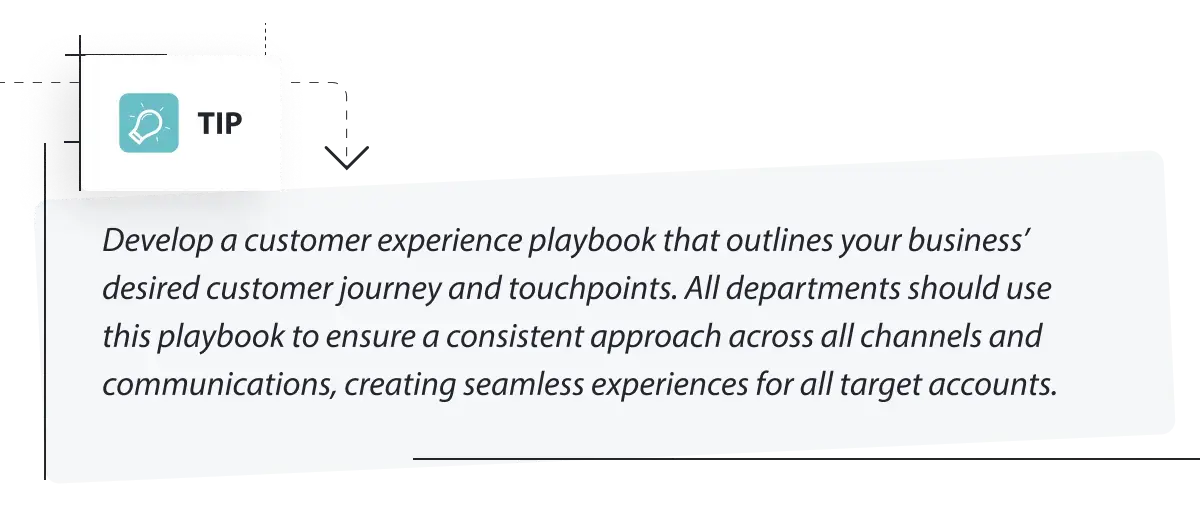
Step five: Measure and optimise
The final step in the ABM process is continuously measuring and optimising your campaigns. This involves tracking key performance indicators and metrics that provide insights into the effectiveness of your ABM efforts. By closely monitoring data metrics, you can determine which strategies are working and which need adjustment.
Optimisation is an ongoing, never-ending process requiring regular analysis and adjustment based on collected data. Use tools like CRM systems and marketing automation platforms to gather and analyse real-time data (more on that below). Implement A/B testing to experiment with different messages and formats and refine your strategies based on what yields the best results.
Setting up regular feedback loops between marketing and sales teams is crucial for optimising ABM efforts. With these, sales teams can provide insights into the effectiveness of marketing materials, while marketing can offer data on engagement and content performance.
This collaboration helps refine buyer insight, improve targeting accuracy, and enhance content relevance. Ultimately, the goal of measuring and optimising your strategy is to improve the ROI for your ABM initiatives, ensuring that your resources are used efficiently to drive maximum value from your target accounts.
ABM metrics and KPIs
Tracking the right metrics is essential for measuring the impact of your ABM strategy and optimising to retain relevance. The four critical dimensions of ABM reporting are awareness, engagement, penetration, and sales, which provide an end-to-end view of your efforts from initial targeting to post-sale account development. Tracking a range of pre and post-sales metrics will help you get this holistic view of your awareness, engagement, penetration, and sales effectiveness.
Pre-sale metrics to monitor include:
- Web traffic by target account to measure the number of website visits from target accounts, indicating their awareness and interest.
- Target account reach to assess the percentage of decision-makers engaged within target accounts, highlighting where more focus might be needed.
- Deal velocity to track the speed at which target accounts move from being marketing-qualified to becoming customers.
- The average contract value offers insights into profitability by indicating the average value of contracts from closed-won accounts.
Post-sale metrics to monitor include:
- Cross-sells and up-sells to measure additional sales made to existing customers, indicating customer satisfaction.
- Referrals to track how many new customers come through existing customer referrals, reflecting customer loyalty.
- Net Promoter Score (NPS) to gauge customer satisfaction and their likelihood of recommending your company.
Integrated dashboards that consolidate data from different sources will help you monitor performance and make informed decisions. Attribution modelling should also be implemented to accurately track interactions across various channels and understand their impact on both ABM campaign performance and any resulting revenue.
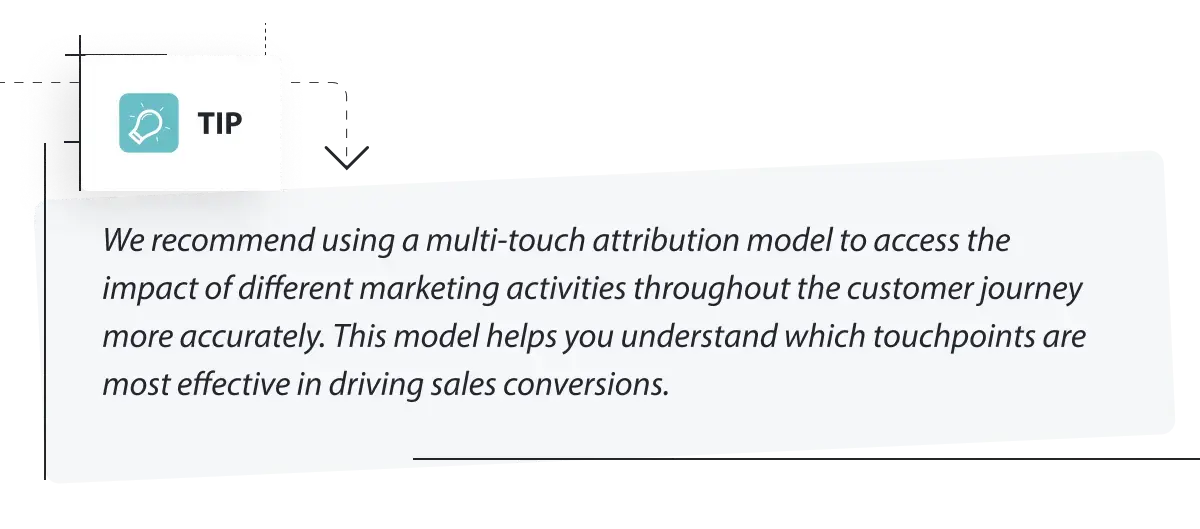
Whatever your approach to monitoring and reporting, review and refine your ABM metrics regularly to align with business objectives and reflect market changes. You can enhance engagement, shorten sales cycles, and improve overall campaign effectiveness by continuously optimising your ABM strategy based on these strategic insights.
ABM tools
Effective tracking and analysis require a robust framework and tools to streamline data collection and analysis. Essential tools in an optimal ABM tech stack include customer relationship management (CRM) systems, marketing automation platforms, data analytics tools, and ABM platforms. These tools enable seamless coordination between marketing and sales teams, supporting targeted outreach and personalised communication.
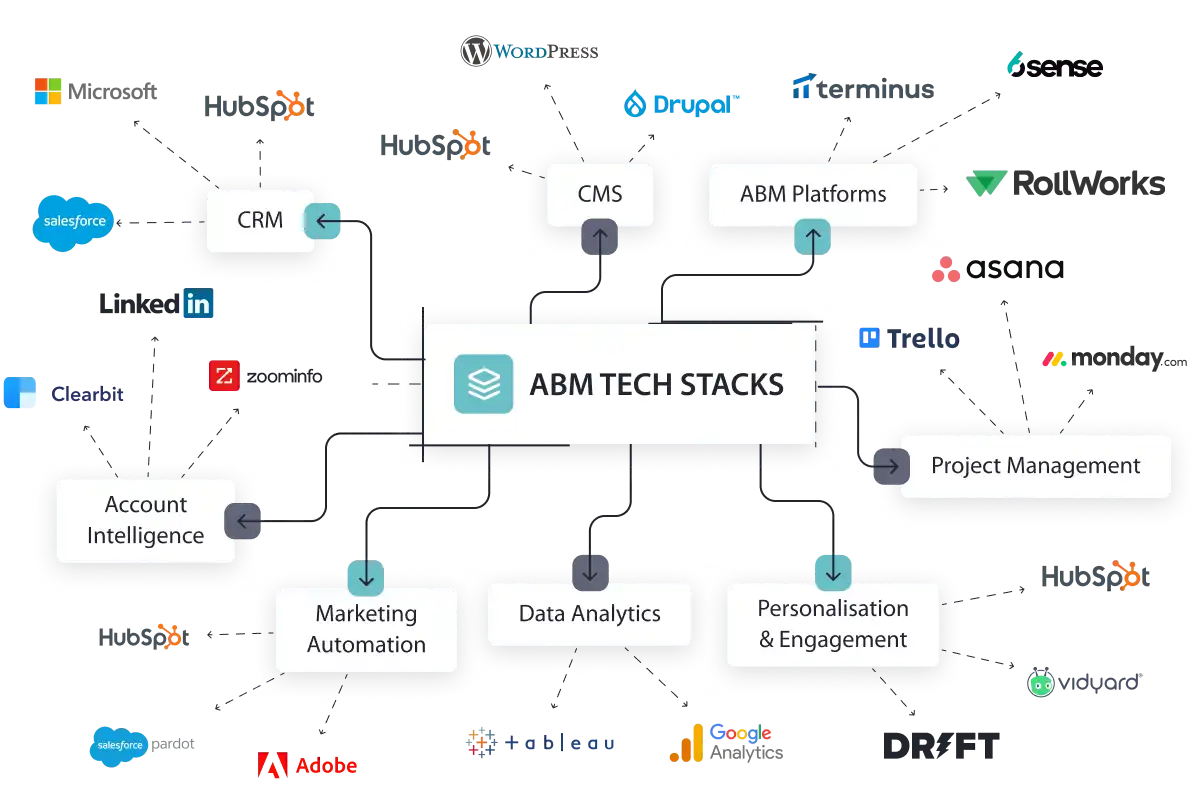
Top-rated CRM systems
- HubSpot CRM: Known for its user-friendly interface, HubSpot CRM helps track customer interactions and manage sales pipelines efficiently. It integrates well with other marketing tools and provides a centralised database for all customer information.
- Salesforce: A more advanced CRM, Salesforce offers robust customisation options and powerful analytics. It is ideal for large organisations needing detailed customer insights and scalable solutions.
Recommended marketing automation platforms
- Marketo: This platform automates marketing campaigns and tracks engagement across multiple channels. Marketo's robust analytics capabilities allow for precise campaign performance measurement, eliminating the guesswork of optimising ABM strategies.
- Pardot: Explicitly designed for B2B marketing, Pardot offers features like lead scoring, email automation, and detailed reporting. It integrates seamlessly with Salesforce, enhancing the effectiveness of sales and marketing alignment.
- HubSpot: HubSpot offers a wide range of automation features, including email marketing, social media management, and analytics, making it a popular choice for ABM marketers already using the HubSpot CRM.
Leading ABM platforms
- Terminus: Terminus is known for its strong account-based advertising capabilities. It allows marketers to engage target accounts through multiple channels, including display advertising, email, and social media, ensuring consistent messaging and higher engagement rates.
- 6Sense: 6Sense is a top-rated data-focused platform with proprietary predictive intelligence, AI, and machine learning capabilities. It strives to provide account insights not readily available elsewhere and enables seamless orchestration for a more successful engagement stack.
Integrating tools like these into your ABM strategy enhances your ability to track your ABM campaign performance and ultimately drive better results from your marketing efforts. By leveraging the strengths of each tool, you can create a cohesive and effective ABM tech stack that supports your growth objectives.
Combining ABM with other strategies
Although they represent two opposite ends of the marketing spectrum, Account-Based Marketing can be combined with inbound marketing to create a full-spectrum approach that maximises marketing efforts.
While ABM focuses on targeted, personalised outreach to high-value accounts, inbound marketing attracts a broader audience through valuable content and nurtures leads through the buyer's journey. Integrating these strategies allows you to leverage the strengths of both approaches: Inbound marketing generates awareness and draws in leads, while ABM ensures that the most promising leads receive personalised attention and tailored messaging.
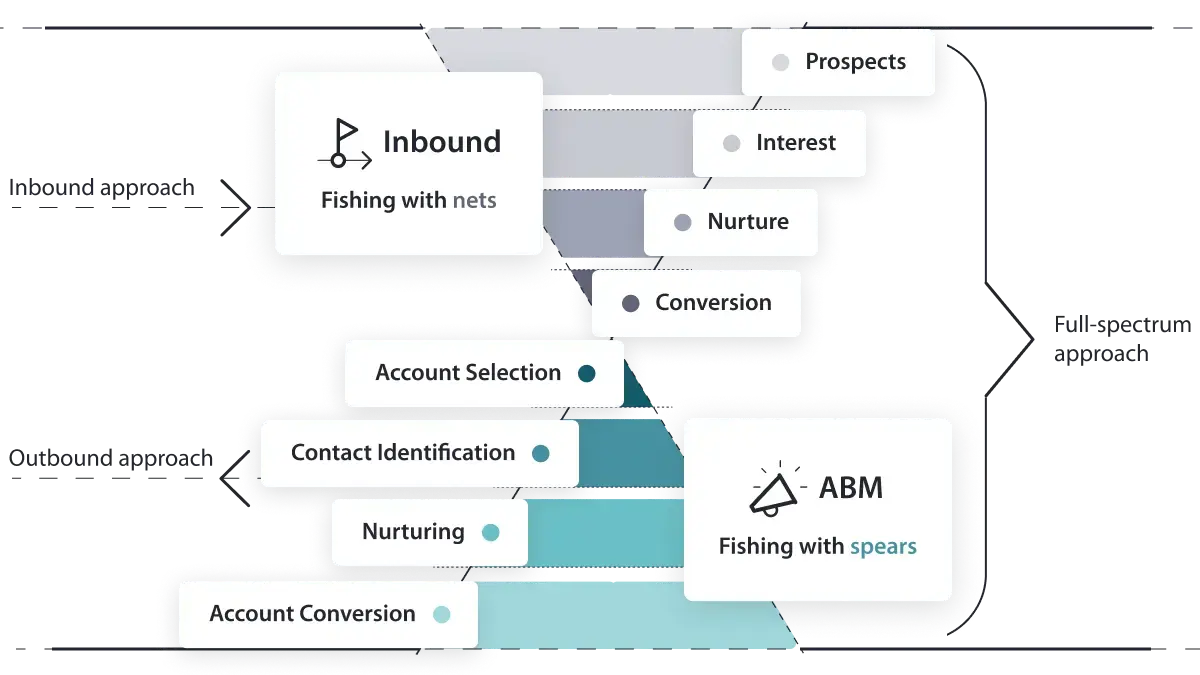
To get this full-spectrum method right, ABM and inbound marketing both require a deep understanding of your ideal customer and buyer personas. This insight helps you create value-driven content that's relatable and relevant to your target audience, addressing their needs and pain points. For instance, the detailed analytics and user behaviour data gathered from inbound marketing efforts can help refine your ABM target list, ensuring you focus on accounts with the highest potential.
Future of ABM
According to the Gartner Hype Cycle, ABM is steadily making its way out of the Trough of Disillusionment and moving up the Slope of Enlightenment, showing that challenges around scaling and automating ABM are no longer slowing marketers down. As ABM continues to evolve and is influenced by technological advancements and shifts in buyer behaviour, here are the ABM trends that will gain traction in the coming months.
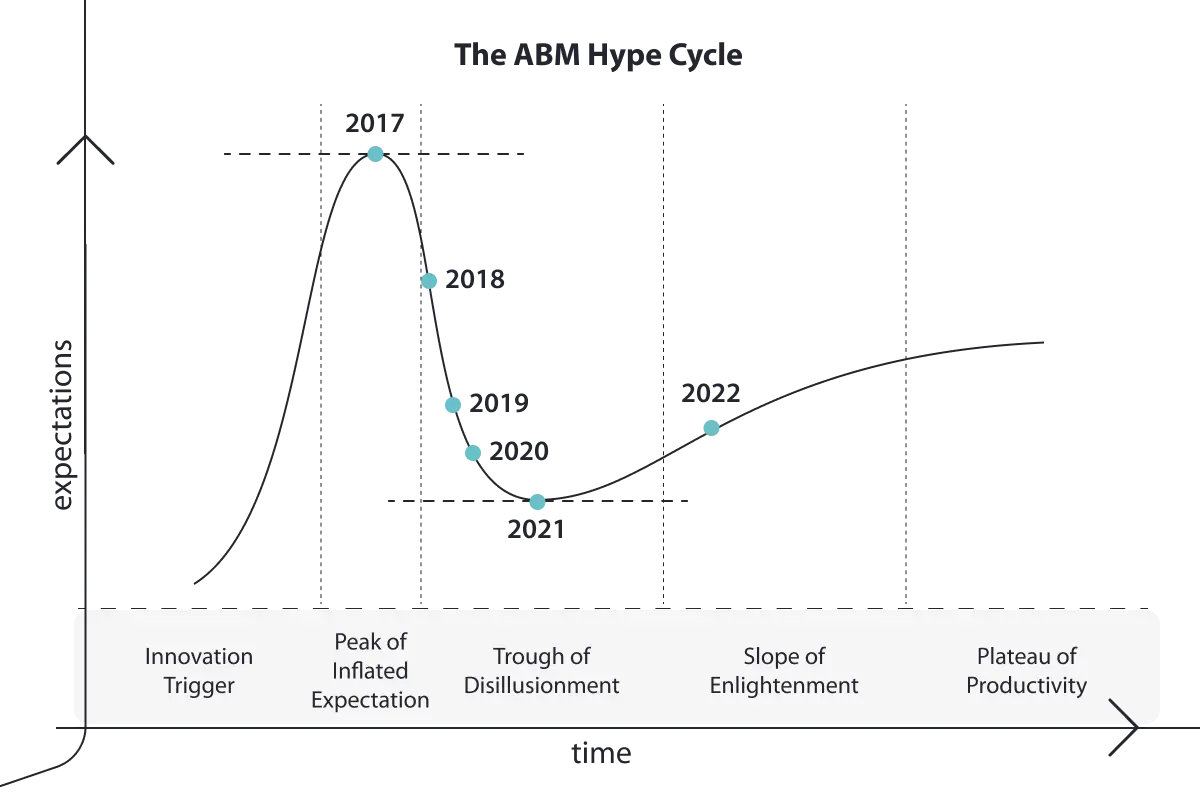
1. Increased personalisation
Thanks to the highly personalised nature of services today, like Netflix and Spotify, buyers increasingly expect more tailored experiences across their digital interactions. As such, ABM’s focus on hyper-personalisation will continue to grow. This will involve leveraging data analytics and AI to create customised content and interactions specific to target accounts.
2. AI and machine learning integration
Steadily becoming part and parcel with the digital tools available on the market, AI and machine learning will play a significant role in automating and optimising ABM campaigns. Using data intelligently, these technologies will help identify high-value accounts, predict buying behaviours, and deliver personalised content at scale.
3. Enhanced data analytics
Advanced data analytics have become crucial for ABM's success. Companies will invest more in tools and platforms that provide deep insights into account activities, engagement levels, and buying signals, enabling more informed decision-making and quick and scalable strategy adjustments.
4. Account-Based advertising
Account-based advertising, especially on LinkedIn, will gain traction as more companies use targeted ads to reach specific accounts across various digital channels. This approach will complement other ABM tactics, enhancing overall campaign effectiveness.
5. ABM for customer retention and expansion
There is a shift towards account-based customer success, where post-sale engagement and customer retention have become central to the ABM strategy. As the lines between sales, marketing and customer success continue to blur, organisations are developing integrated teams, including customer services, that work closely together to target, nurture and retain key accounts.
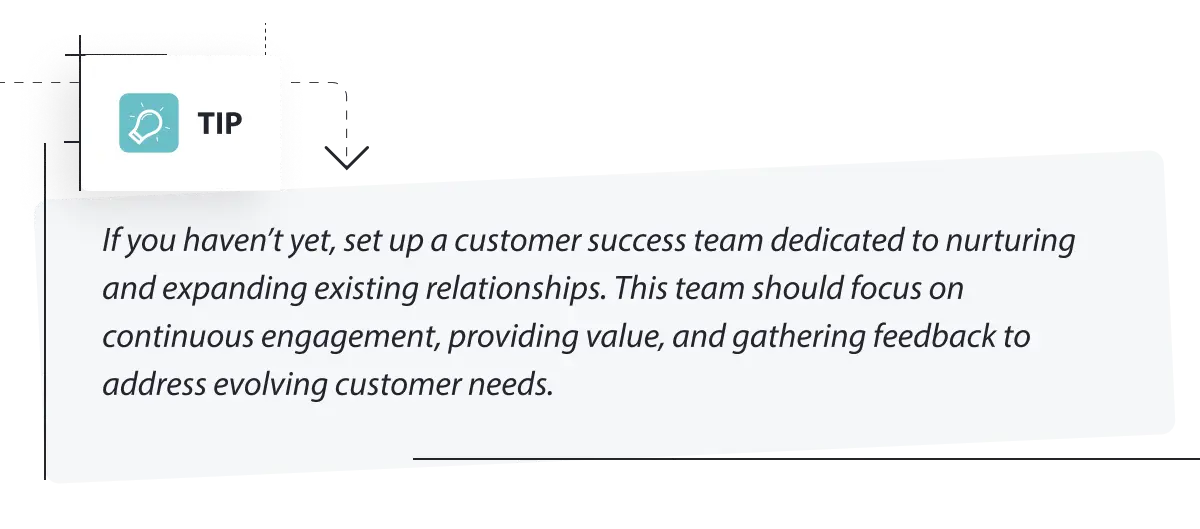
6. Use of intent data
Intent data will become more integral to ABM strategies. It will help companies understand which accounts are in the market for their solutions and what topics they are interested in. This data can guide content creation and engagement strategies.
7. Scalable ABM strategies
Companies will develop scalable ABM strategies to cater to different tiers of accounts. While high-value accounts may receive one-to-one attention, mid-tier and lower-tier accounts benefit from one-to-few or one-to-many ABM approaches, ensuring broader coverage without sacrificing personalisation.
Conclusion: Your checklist for ABM success
Incorporating ABM into your overall marketing strategy allows for better alignment between sales and marketing and fosters stronger, long-term relationships with your most valuable customers. By adopting ABM, contract manufacturers can gain a competitive edge in the digitally driven market, achieve sustainable growth, and see increased ROI on marketing and sales investments.
The ABM strategy checklist for B2B contract manufacturers
| ✅ | Have your sales and marketing teams worked together to identify a good number of relevant high-value target accounts with the highest revenue potential? |
| ✅ | Have teams defined each target account's buying committee and the individual buyer personas within each account involved in making the purchasing decision? |
| ✅ | Does your business have a robust ABM tech stack with a CRM, marketing automation, and ABM platform? |
| ✅ | Has marketing created personalised content for the buyer's awareness, consideration, and decision-making journey? |
| ✅ | Are teams actively engaging with key accounts and providing every possible opportunity for conversion? |
| ✅ | Have teams agreed to track the campaign metrics and KPIs for ongoing monitoring and optimisation? |
| ✅ | Are teams proactively using campaign data insights to refine their ABM strategy? |
| ✅ | Are teams combining ABM and inbound marketing tactics for a full-spectrum, cross-funnel approach? |
| ✅ | Are sales, marketing and customer service teams integrated, aligned and working cohesively towards the same revenue goals? |
If you'd like support from an ABM agency with extensive B2B manufacturing industry experience, contact the Equinet team now.
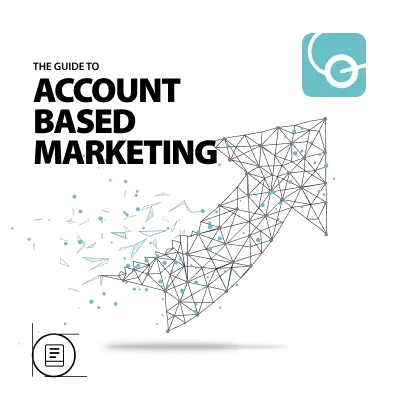
Want to save a copy? Well send a copy direct to your inbox.























